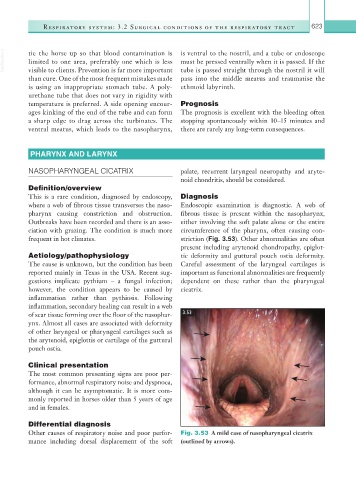Page 648 - Equine Clinical Medicine, Surgery and Reproduction, 2nd Edition
P. 648
Respir atory system: 3.2 Surgical conditions of the respir atory tr act 623
VetBooks.ir tie the horse up so that blood contamination is is ventral to the nostril, and a tube or endoscope
must be pressed ventrally when it is passed. If the
limited to one area, preferably one which is less
visible to clients. Prevention is far more important
pass into the middle meatus and traumatise the
than cure. One of the most frequent mistakes made tube is passed straight through the nostril it will
is using an inappropriate stomach tube. A poly- ethmoid labyrinth.
urethane tube that does not vary in rigidity with
temperature is preferred. A side opening encour- Prognosis
ages kinking of the end of the tube and can form The prognosis is excellent with the bleeding often
a sharp edge to drag across the turbinates. The stopping spontaneously within 10–15 minutes and
ventral meatus, which leads to the nasopharynx, there are rarely any long-term consequences.
PHARYNX AND LARYNX
NASOPHARYNGEAL CICATRIX palate, recurrent laryngeal neuropathy and aryte-
noid chondritis, should be considered.
Definition/overview
This is a rare condition, diagnosed by endoscopy, Diagnosis
where a web of fibrous tissue transverses the naso- Endoscopic examination is diagnostic. A web of
pharynx causing constriction and obstruction. fibrous tissue is present within the nasopharynx,
Outbreaks have been recorded and there is an asso- either involving the soft palate alone or the entire
ciation with grazing. The condition is much more circumference of the pharynx, often causing con-
frequent in hot climates. striction (Fig. 3.53). Other abnormalities are often
present including arytenoid chondropathy, epiglot-
Aetiology/pathophysiology tic deformity and guttural pouch ostia deformity.
The cause is unknown, but the condition has been Careful assessment of the laryngeal cartilages is
reported mainly in Texas in the USA. Recent sug- important as functional abnormalities are frequently
gestions implicate pythium – a fungal infection; dependent on these rather than the pharyngeal
however, the condition appears to be caused by cicatrix.
inflammation rather than pythiosis. Following
inflammation, secondary healing can result in a web
of scar tissue forming over the floor of the nasophar- 3.53
ynx. Almost all cases are associated with deformity
of other laryngeal or pharyngeal cartilages such as
the arytenoid, epiglottis or cartilage of the guttural
pouch ostia.
Clinical presentation
The most common presenting signs are poor per-
formance, abnormal respiratory noise and dyspnoea,
although it can be asymptomatic. It is more com-
monly reported in horses older than 5 years of age
and in females.
Differential diagnosis
Other causes of respiratory noise and poor perfor- Fig. 3.53 A mild case of nasopharyngeal cicatrix
mance including dorsal displacement of the soft (outlined by arrows).

